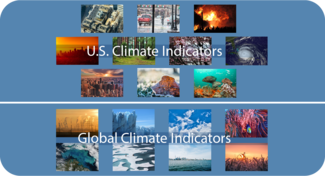Scientific partners continue to follow indicators of a changing climate

Several key environmental factors guide an ongoing effort to understand global changes in climate. They are tracked as part of a sustained assessment of the state of the climate that supports scientific study, shows risks and vulnerabilities, and sets future priorities.
Eighteen indicators of global change, also called “climate indicators,” show trends over time in key aspects of Earth’s atmosphere, oceans, and environmental conditions. They underpin the work of a collaboration of more than a dozen federal departments and agencies that contribute to public scientific knowledge through the U.S. Global Change Research Program (USGCRP).
NOAA and many of its divisions and affiliates, including NCEI, the Climate Program Office (CPO), and the Cooperative Institute for Satellite Earth System Studies (CISESS), contribute to the work of USGCRP, which regularly updates the status of the eighteen climate indicators and considers new ones.
Climate Indicators: Markers of Change
Climate indicators are woven into the National Climate Assessment, a comprehensive, federally mandated report compiled by the USGCRP every four years from input by teams of regional and scientific experts. Since the 2018 release of the Fourth National Climate Assessment (NCA4), each climate indicator has been slated for an update. By updating the indicators with the most current information available, scientists continue to add relevance to the dialogue and the study of climate across the globe. In addition to upkeep of the existing indicators, USGCRP and its participating agencies also evaluate potential new indicators for the platform.
USGCRP’s eighteen indicators include:
National
- Atlantic Tropical Cyclone Days: Changes in the yearly tropical cyclone activity in the Atlantic Ocean.
- Billion Dollar Disasters: The yearly number and type of weather and climate disasters in the United States that exceed one billion dollars in direct losses.
- Frost-Free Season: The number of frost-free days in a year, an indication of the length of the growing season.
- Heat Waves: Trends in multi-day extreme heat events in 50 major U.S. cities.
- Heating and Cooling Degree Days: The number of degrees by which the average daily temperature is lower or higher, respectively, than 65°F. Degree days are used as a proxy for energy demand for heating or cooling buildings.
- Heavy Precipitation: Measures of the relative amount of annual rainfall from large, single-day precipitation events and their change over time.
- Marine Species Distribution: Changes in the location of fish, shellfish, and other marine species along the coast due to warming ocean temperatures.
- Start of Spring: Changes in the date each year when enough heat has accumulated to initiate leafing and flowering in temperature-sensitive plants.
- Terrestrial Carbon Storage: Annual changes in carbon stored in living and dead organic matter above and below the ground.
- U.S. Surface Temperatures: Observed annual changes in temperature across the contiguous United States.
Global
- Annual Greenhouse Gas Index: A measure of the capacity of Earth’s atmosphere to trap heat as a result of the presence of long-lived greenhouse gases.
- Arctic Glacier Mass Balance: The cumulative change in mass balance (net gain/loss of snow and ice) of eight glaciers north of the Arctic Circle since 1945.
- Arctic Sea Ice Extent: A measure of the area of the Arctic Ocean where there is at least some sea ice.
- Atmospheric Carbon Dioxide: Global monthly average concentration of CO2 in the atmosphere measured at 40 sites around the globe.
- Global Surface Temperatures: The long-term annual record of global temperatures.
- Ocean Chlorophyll Concentrations: An annual measure of the chlorophyll concentration that indicates the amount of phytoplankton in the ocean.
- Sea Level Rise: Changes in annual average global sea levels due to thermal expansion and melting of ice sheets and glaciers.
- Sea Surface Temperatures: Shows annual average temperatures in the upper 10 meters of the ocean.
Climate indicators are selected by USGCRP’s participating agencies based on several conditions. Each indicator must be supported by regularly updated federal data sources, such as NCEI’s Global Historical Climatology Network (GHCN) data and the Billion-Dollar Disasters tally. Additionally, indicators must have peer-reviewed protocols in place and cover a broad geographic area, among other requirements.
Of the thirteen agencies that participate in USGCRP, eight are federal departments, specifically Agriculture, Commerce, Defense, Energy, Health & Human Services, Interior, State, and Transportation. Along with NCEI and CPO, other NOAA agencies include Earth System Research Laboratory and the National Marine Fisheries Service. Other supporting agencies are the EPA, NASA, National Science Foundation, Smithsonian Institution, U.S. Forest Service, and U.S. Agency for International Development.




